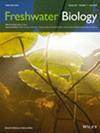Ice Age Biogeography Corresponds With Current Climate Vulnerability of Freshwater Fishes
IF 2.7
2区 生物学
Q2 ECOLOGY
引用次数: 0
Abstract
- Both local environmental factors and historical biogeography shape ecological communities, but determining which historical biogeographical patterns correspond with contemporary climate vulnerability is an underused conservation method. The historical colonisation patterns of freshwater fishes following the Pleistocene (‘Ice Age’) glaciations offer an ideal model for comparing historical biogeography and climate-change vulnerability.
- We used current thermal niches and future stream-temperature projections to estimate the climate vulnerability of 29 Great Plains and Rocky Mountain fishes that we classified as either early or late colonists of the region in the wake of glacial retreat (~19,000 years ago).
- Ninety-three percent of the most vulnerable species were amongst the earliest colonists of the region and we consider ‘postglacial-pioneer species’. Median predicted site loss (number of historically occupied sites predicted to become too warm by end-of-century) was 0% for late colonising species and 33% for early colonising species.
- We provide empirical evidence that postglacial-pioneer fishes are uniquely vulnerable to climate change, and we suggest this may apply to many taxa from formerly glaciated regions. More broadly, we demonstrate that evaluating the relationship between current species-environment patterns and historical biogeography may be a fruitful avenue for future climate change and conservation research.
冰河时代生物地理与当前淡水鱼的气候脆弱性相对应
当地环境因素和历史生物地理都能塑造生态群落,但确定哪些历史生物地理格局与当代气候脆弱性相对应是一种未充分利用的保护方法。在更新世(“冰河时代”)冰川之后,淡水鱼的历史殖民模式为比较历史生物地理学和气候变化脆弱性提供了一个理想的模型。我们使用当前的热生态位和未来的河流温度预测来估计29种大平原和落基山脉鱼类的气候脆弱性,我们将这些鱼类归类为冰川退缩(~ 19000年前)后该地区的早期或晚期殖民者。93%的最脆弱物种是该地区最早的殖民者,我们认为是“冰川后先锋物种”。中位数预测的地点损失(历史上占据的地点的数量,预计到本世纪末将变得太热)在晚期殖民物种中为0%,在早期殖民物种中为33%。我们提供的经验证据表明,冰川后先锋鱼类对气候变化具有独特的脆弱性,我们认为这可能适用于许多来自前冰川地区的分类群。更广泛地说,我们证明评估当前物种环境模式和历史生物地理学之间的关系可能是未来气候变化和保护研究的一个富有成效的途径。
本文章由计算机程序翻译,如有差异,请以英文原文为准。
求助全文
约1分钟内获得全文
求助全文
来源期刊

Freshwater Biology
生物-海洋与淡水生物学
CiteScore
5.90
自引率
3.70%
发文量
162
审稿时长
2 months
期刊介绍:
Freshwater Biology publishes papers on all aspects of the ecology of inland waters, including rivers and lakes, ground waters, flood plains and other freshwater wetlands. We include studies of micro-organisms, algae, macrophytes, invertebrates, fish and other vertebrates, as well as those concerning whole systems and related physical and chemical aspects of the environment, provided that they have clear biological relevance.
Studies may focus at any level in the ecological hierarchy from physiological ecology and animal behaviour, through population dynamics and evolutionary genetics, to community interactions, biogeography and ecosystem functioning. They may also be at any scale: from microhabitat to landscape, and continental to global. Preference is given to research, whether meta-analytical, experimental, theoretical or descriptive, highlighting causal (ecological) mechanisms from which clearly stated hypotheses are derived. Manuscripts with an experimental or conceptual flavour are particularly welcome, as are those or which integrate laboratory and field work, and studies from less well researched areas of the world. Priority is given to submissions that are likely to interest a wide range of readers.
We encourage submission of papers well grounded in ecological theory that deal with issues related to the conservation and management of inland waters. Papers interpreting fundamental research in a way that makes clear its applied, strategic or socio-economic relevance are also welcome.
Review articles (FRESHWATER BIOLOGY REVIEWS) and discussion papers (OPINION) are also invited: these enable authors to publish high-quality material outside the constraints of standard research papers.
 求助内容:
求助内容: 应助结果提醒方式:
应助结果提醒方式:


